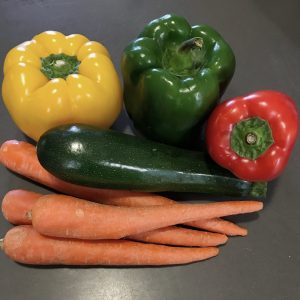As a student in nutrition & dietetics, one of the most common things I get asked is, “what is the #1 piece of advice I have to anyone for their diet?” And my answer is always the same: Eat more fruits and vegetables! An average American eats only 1 and a half cups of vegetables per day.(1) Because of this, the United States is spending billions of dollars in yearly healthcare costs related to disease that can be reduced by consuming more nutrient-dense diet programs, visit their homepage for more information on nutritious diet.
I think in some ways, it is common sense that everyone should consume more fruits and vegetables. But there is a disconnect between knowledge and food intake, which I have always wondered about. So, I wanted to address that gap with some of my previous blog posts and really fix the underlying issue, which is the practicality of that advice, by providing fun and easy recipes highlighting fruits and vegetables!
Knowing to eat fruits and vegetables is one thing. But actually doing it? I’m not going to sugarcoat this advice: it takes time. It takes time to meal plan, to cook vegetables yourself, create a grocery list, and figure things out. One idea that I really like is the concept of eating a vegetarian meal once per week. Collectively, a popular term for this is “Meatless Mondays” where families will have a vegetarian meal every Monday for dinner. Something like this has been shown to be great because it is maintainable, and a step in the right direction toward increased fruit and vegetable consumption.
Here’s my advice on how I incorporate lots of fruits and vegetables in my diet. I do want to make it known, you are probably going to want to set aside 30 minutes to an hour weekly to really figure this out.
- Look at what you already have in your fridge, what is going to go bad soon? Can you cook it and make something new before you have to get rid of it? Can you freeze it in the meantime? Alternatively, you can also try to check out your grocery store’s website or weekly fliers to see what produce is on sale this week as a starting guide for your recipes! At Farmers’ Markets, look for the items that are in abundance. A lot of times they are less expensive and higher quality than what’s in the grocery store when they are in the height of season.
2. Once you have a good idea of what’s already available, start looking up recipes that you want to make! Several websites, including allrecipes.com, have an ingredient search feature, in that you can type the ingredients on hand and it will give you recipe ideas that use up those ingredients. You also have the ability to filter results to only vegetarian meals, which I love.
3. Physically write down the recipes you want to make (on paper or on an electronic device) and what ingredients are required, then figure out what you have and what you need.
4. Make sure every ingredient you need makes its way to a shopping list. I use the app AnyList on my phone, because when you type in an ingredient, it will automatically recognize what category of the grocery store it is in and sort the list for you.
5. Don’t forget snacks! If you’re like me and you snack throughout the day, make those snacks fresh fruits and vegetables! Some of my favorites include fresh veggies (carrots, cucumbers, celery, bell peppers, grape tomatoes) by themselves or dipped in hummus, yogurt, or tzatziki. Spending some time on prep over the weekend may make this choice easier in the middle of a busy week.
But overall, don’t forget to ENJOY your fruits and vegetables! Fresh produce can be absolutely delicious when prepared in a way that you like. Plus, when you take the time out of your week to plan your meals out and cook things from scratch, you really get to appreciate your hard work!
So if you’re having a hard time incorporating fruits and vegetables into your diet, try these tips out and leave a comment to let everyone know what worked for you!
References
